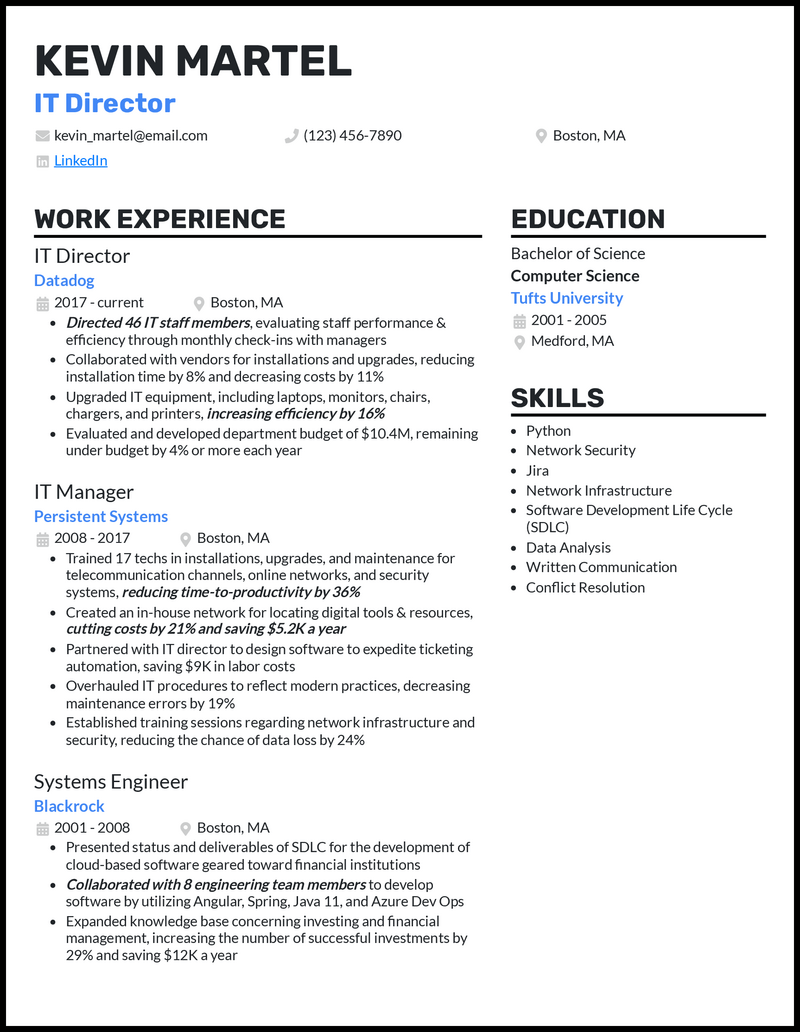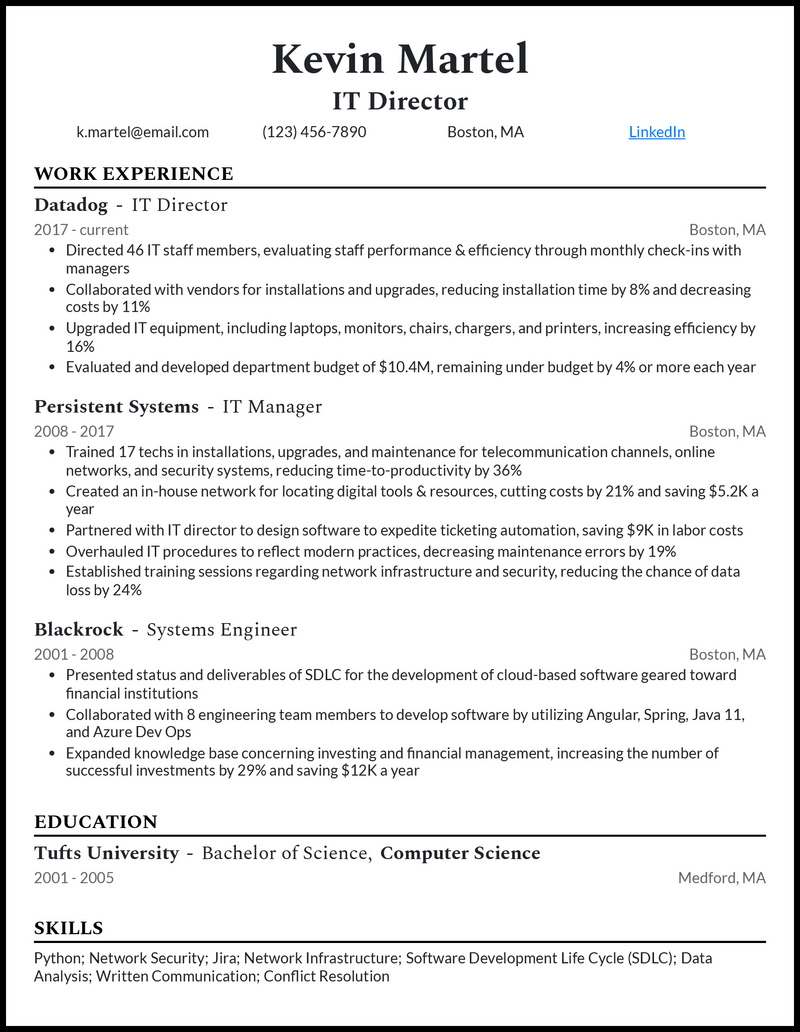As an IT director, you bridge the gap between an in-depth knowledge of various technologies and leading successful departments. Under your watchful eye, the IT department thrives, keeping the entire organization running smoothly.
When the time comes for you to find a new job, you might find yourself with a unique problem—you’ve already done and learned so much that it doesn’t fit inside a one-page resume.
That’s what we’re here for. Our IT director resume examples and expert cover letter writing advice will show you how to highlight your varied skill set in a way that gets you your new job.
Related resume examples
What Matters Most: Your IT Skills & Leadership Experience

Your intimate knowledge of IT dates back to many years ago, and although time has passed, you’ve kept up to date with things. From Python and its frameworks, such as Django and Flask, to Java, Spring, and Hibernate, you’re keeping up with the latest trends, even if you’re not expected to do a lot of hands-on coding.
That understanding extends far past programming, though. You’re familiar with the latest infrastructures, cybersecurity risks, and network administration techniques. All of those technical topics fit perfectly into your resume, and if you can match them up with the job description, that’s even better.
Of course, being an IT director, your main responsibilities revolve around leading successful teams and departments, so you can throw some of those skills in here too.
9 most popular IT director skills
- Microsoft Office
- Python
- Tableau
- Java
- Microsoft Project
- AWS
- Agile/Scrum/Kanban
- ITIL Methodologies
- Project Management
Sample IT director work experience bullet points
At this point in your career, you’ve got a truly brag-worthy list of accomplishments. Let them shine instead of talking about your daily responsibilities.
After all, saying that you “attended meetings” is much less exciting than elaborating and saying that you liaised with major stakeholders and vendors to improve the IT budget efficiency.
You’re no stranger to tracking various KPIs, be it productivity or network uptime, not to mention juggling multiple budgets. Add those numbers to your resume to truly make the most of it and capture the attention of hiring managers.
Here’s how to use numbers to your advantage:
- Directed 46 IT staff members, evaluating staff performance and efficiency through monthly check-ins with managers
- Oversaw an annual IT budget of $3M, leveraging strategic sourcing and vendor negotiations to reduce overall IT costs by 13% year-over-year
- Led the implementation of an ITIL-based service management framework, improving IT service delivery and customer satisfaction by 39%
- Directed the cybersecurity program, implementing stronger protocols and staff training to reduce security incidents by 37%

How to Add Certifications to Your IT Director Resume
With the many technical abilities you have, like coding in Python and overseeing software development lifecycles, having the right certifications on your IT director resume will help reassure hiring managers of your skills.
To add a certifications section, place it below your information technology education and skills sections. Each IT director certification you list should include:
- The certification’s name, such as Certified Information Security Manager
- The organization you received it from, such as ISACA
- The date you received it
- Its expiration date (when applicable)

The best certifications for IT director resumes
While IT has many best practices, companies will often have different programs and coding languages they work with, depending on their needs. So, tailor the ones you list to the positions you’re applying to. For example, while applying to a company that uses JIRA, showing you’re a JIRA-certified expert would give you a leg up.
Here are some of the most popular certifications for IT directors:
- Certified in the Governance of Enterprise IT: This is a great option for IT directors seeking a lead role. It showcases your abilities to run efficient IT systems, analyze risk profiles, and oversee professional teams.
- Certified Information Security Manager: Every organization must be wary of external threats when planning IT systems. Being certified in information security will show your knowledge of password protection, secure leadership, and ransomware attack response.
- COBIT Foundation Certificate: The COBIT framework is rising in popularity in IT systems management. Having this certificate on your resume will show you can take a holistic approach to management by balancing stakeholder needs, efficient service delivery, and managing communications between departments.
Other in-demand certifications for IT directors are:
Top 5 Tips for Your IT Director Resume
- Show that you’re up to date
- To show that you’re in touch with IT trends, mention the conferences you attend, such as Gartner IT Symposium or the CIO Summit. If you’re invited to speak or present, or receive any awards, such as the CIO 100, make sure to include them in your resume too.
- Add extra credentials
- You’re nearing the top of the IT ladder, but it never hurts to flex your credentials. If you have any relevant certifications, such as the CISSP, PMP, or CISA, throw them in. You might also want to include other certs based on your specific industry, such as the ITIL MP for IT directors who work in service delivery.
- Mention your team’s successes
- The successes of those who work under your leadership are your achievements too. Showcase your ability to lead successful departments and teams by including things your teams have done and the impact they have had on the entire organization, such as reducing network downtime.
- Tailor your resume
- As an IT director, you probably get LinkedIn connections from recruiters fairly regularly. However, it’s important to still show that you care once an interesting job comes along. Do this by tailoring your resume for each job, swapping skills and work experience in and out as needed.
- Discuss your financial acumen
- A huge part of your job involves setting budgets, targets, and KPIs, and managing the finances of the IT department. To impress hiring managers, use financial figures to talk about your successes, such as leading the migration to the cloud to save costs.
You have robust IT experience, so a career summary can help it pop right at the start of your resume. Use it to express your interest in the role (mention the company by name!) and include one career-defining achievement.
It’s best to keep to a single-page resume, so depending on the length of your experience, that might be hard. Use the reverse-chronological format (most recent job at the top) and stick to relevant roles in IT management.
You can, but your leadership skills are better expressed in the work experience bullet points and in the cover letter. If you include any, make them specific, such as hiring and training or performance appraisals.








